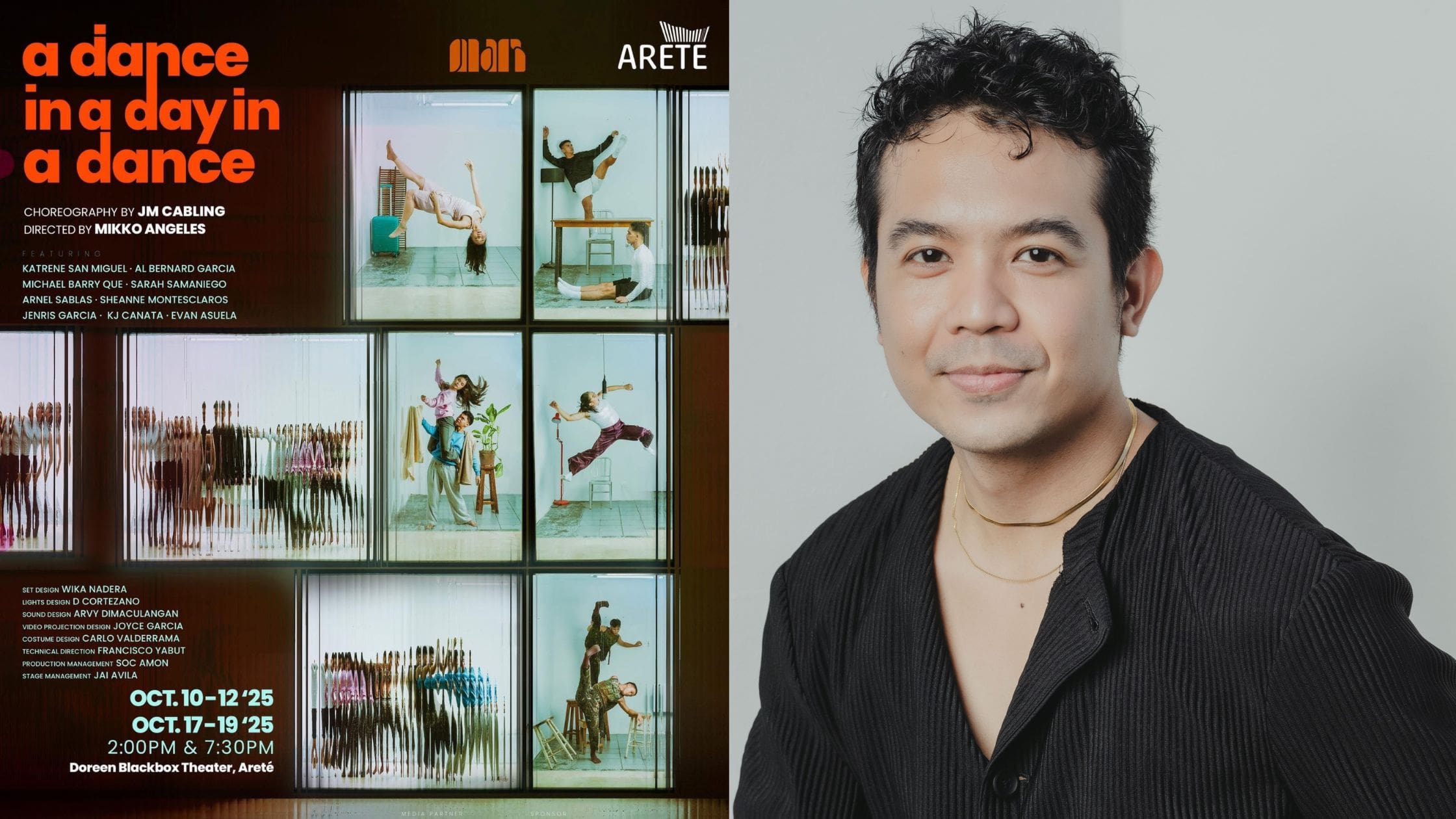
From Vision to Stage: JM Cabling Steps Forward as the Man of the Hour
National Artist Agnes Locsin, Douglas Nierras, and the late Tony Fabella turned choreography into poetry—works that breathed music and revealed the Filipino psyche. Their craft deepened with time. Into this celebrated lineage steps Japhet Mari “JM” Cabling, the youngest to claim a seat at the table. Before he turned 30, Cabling already staged dances for the Southeast Asian Games in 2019, the Dubai World Expo in 2020, and a string of landmark musicals—his breakout “Mula sa Buwan,” followed by “Himala: Isang Musikal,” and “Lam-ang: An Ethno-epic Musical.” His latest gig is being associate choreographer to Emmy awardee Karla Garcia Puno, the director for Theater Group Asia’s much-anticipated “A Chorus Line.”
Now, after years of shaping other people’s visions, the 32-year-old choreographer is stepping into the spotlight with the launch of Mari Dance, his company of kindred spirits and longtime collaborators, debuting with “A Dance in a Day in a Dance” at Ateneo’s Areté.
Aside from being his company’s namesake, Mari can also mean maari—what is possible. To survive as an artists’ collective without patronage, Mari Dance, like many independent dance groups in the Philippines, follows a business model that takes on commercial projects for special events and provincial fiestas, while striving to balance them with artistic work. It draws on a network of dancers who can adapt to a client’s needs. By contrast, ”A Dance in a Day in a Dance” marks its first purely artistic endeavor, staged in partnership with Guang Ming College Tagaytay and the Guang Ming Dance Project, where Cabling serves as artistic director.
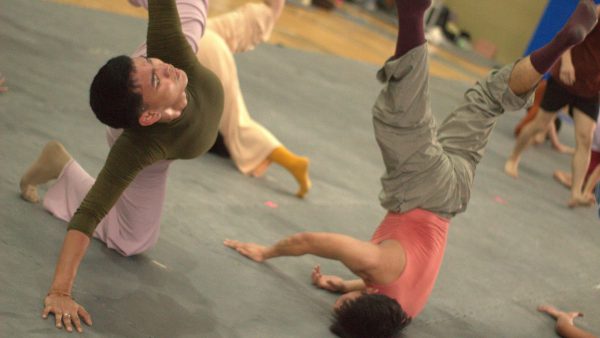
The appeal of the dancers from Guang Ming College is their lack of inhibition and rawness; Photo c/o Mari Dance
A big factor in forming Mari Dance, Cabling adds, was that most of the senior dancers in the cast are also his colleagues on the Guang Ming College faculty and alumni from the University of the Philippines Dance Program—Michael Que, Abbey Carlos, Sarah Samaniego, and Ricca Bautista. Cabling’s vision for the company is clear: “Dance should be a sustainable career, especially for freelancers like me.” It is a principle he has lived by since graduating cum laude from UP’s College of Dance a decade ago.
He credits his mentors for shaping this outlook. From Victor Flor, his folk dance teacher at the Philippine High School for the Arts, he gained grounding in tradition and discipline. Through Elena Alvarez’s nurturing in contemporary dance, he learned to trust his instincts and allow intuition to shape his choreography. From Steve Villaruz at UP, his composition teacher, he absorbed a deep respect for craft and the architecture of movement. During his stint at Dulaang UP, director José Estrella influenced him to think like a theater director—understanding the intention and motivation behind every step. This exposure to folk dance, contemporary practice, and theater fused into his choreographic voice, marked by clarity of storytelling.
“My work should be understood by my mother, who isn’t exposed to shows like this,” Cabling says. “I want to make the dances easy to understand.”
AGENTS OF MEANING
“A Dance in a Day in a Dance” brings together some of Cabling’s works, framed as a company in rehearsal for the thriller “Lihim Ni Lea” and their struggle under a tyrannical choreographer. Interwoven into this frame are glimpses of the dancers’ inner worlds through pieces such as “Bent,” “Nothing Special,” and “I Wanna Say Something.” The work underscores that behind the spectacle of theater lies the intricate psyche and private lives of the artists themselves.
The production team are this generation’s Whos’ Who that admired Cabling’s works: Mikko Angeles for direction, Wika Nadera for set design, Arvy Dimaculangan for sound design, and D Cortezano for lights design. Video artist Joyce Garcia’s projection mapping adds a cross-disciplinary dimension, layering visual art onto Cabling’s choreography and deepening the work’s theatrical texture.
“Bent” is a taut duet about gender-bending roles and shifting relationship dynamics. Part funny, part dramatic, it unfolds as an exchange between a female dancer and her BFF. It begins with attraction—a hot tango that swells into intimacy—before slipping into guilt. It not only crosses the boundaries of friendship, but also highlights the male’s deeper conflict as a gay man asking, “Why am I doing this?” Cabling’s choreography reveals itself not only through bodies but through objects. Towels, draped, dropped and twirled become markers of transition—of desire, shame, reconciliation—symbols of gender’s fluid edges and the fragile stages of intimacy.
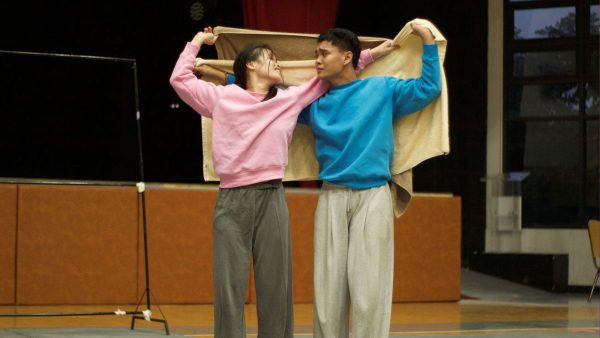
Bent is a duet on gender fluidity; Photo c/o Mari Dance
Props return as vessels of meaning throughout his works. In “Lihim ni Lea,” Al Garcia plays the father as predator who preys on his daughter, Katrene San Miguel. The narrative seems fantastical at first: a girl confides to her teacher that she has special powers seeping through the walls of neighboring condominium units. In truth, it is the victim’s imagination—a coping mechanism for incest. The staging heightens this duality. The set is built from movable modules that shift with ease, suggesting walls that dissolve, homes that collapse into each other, and boundaries that never hold. (The design originally came from director Tuxqs Rutaquio and executed for this show by Nadera.) Within this pliable architecture, San Miguel slips through walls of garters so that only parts of her body emerge, as if surfacing in one room and reappearing in another. The imagery—drawn from Japanese variety shows where contestants morph into human bowling pins—lands somewhere between whimsical and haunting, humor as a mask for trauma.
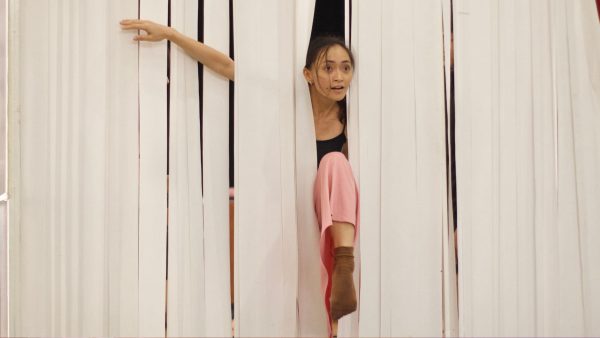
Katrene San Miguel dances the title role in Lihim Ni Lea; Photo c/o Mari Dance
FAMILIAR BECOMES STRANGE
In “I Wanna Say Something”, the prop is a suspended microphone. When a dancer, KJ, is replaced mid-rehearsal for not measuring up to the director, time freezes. Michael Que, steps in as KJ’s psyche, voicing the displaced dancer’s inner turmoil: “Do I apologize? Do I rage? Do I stay silent?” As the microphone loops around the stage, its swinging orbit alters the choreography, mapping the space and magnifying every hesitation. It becomes at once a literal tool, a symbolic burden, and the voice of the unspoken. San Miguel appears again—not as character, but as spark, that fragment of hope urging the dancer, “Go on.” The ensemble moves like firing neurons in KJ’s brain, sparking connections and misfires that mirror his inner turmoil. Cabling’s group choreography thrives on rhythm: Dancers weave in and out of patterns like shifting currents, their bodies playing off one another in pulsing waves of energy.
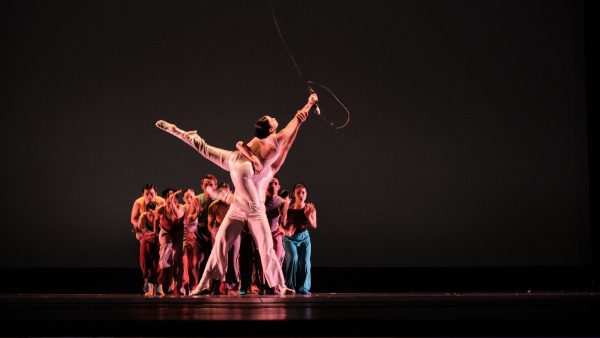
I Wanna Say Something is a dialogue between repression and expression of emotions; Photo c/o Mari Dance
Even in “Nothing Special,” a meditation on freedom of movement, Cabling turns staging into a kind of prop. The work unfolds inside an eight-foot square of light, a glowing box just large enough to contain two bodies. The box suggests either confinement or possibilities.
Cabling recalls an untrained schoolmate who danced with complete abandon after watching the dance majors’ concerts. His unguarded freedom contrasted sharply with peers whose bodies, though disciplined by years of technique, often felt inhibited. Within the illuminated square, the choreographer confronts his younger, innocent self and recognizes how overwork and too many responsibilities have made him rigid and critical. The box becomes more than a stage. At once cage and portal, it frames the different ways bodies negotiate freedom. That dance becomes an “aha!” moment for the choreographer, brought to life by Garcia.
The program closes with the choreographer—at once creator and taskmaster—casting a stark reflection on the dance world itself. The irony is piercing. Dancers may quietly carry their traumas and anxieties in the studio, yet it is the choreographer who sets the tone of the rehearsal and holds the power to make change. “Dance training shouldn’t be like this,” Cabling says. “It should be healthier.”
Across these works, towels, garters, microphones, and even light itself become part of Cabling’s vocabulary—not just accessories but storytelling devices that make the familiar strange, transforming both objects and the act of survival into art.
FREEDOM AS A DANCER
Michael Que and Al Garcia have known Cabling since their days as folk dance majors at the Philippine High School for the Arts. They have witnessed his growth from a demanding dance maker into a choreographer whose craftsmanship reveals a deep understanding of the Filipino psyche and movement. His choreography, they say, feels organic, shaped by a keen aesthetic sense and vision.
Garcia observes that as Cabling has matured, his vision and direction have become sharper. “His style and technique have a sense of play,” Garcia says in Tagalog. “His work is deeply musical—and beautiful. JM loves playing with rhythm. He’s always exploring the spaces between the beats, between one movement and the next. He is demanding because he requires a very high level of technique, yet he’ll also disrupt his own patterns. He has mastered the craft he once only experimented with at UP, especially the challenge of choreographing for large ensembles.”
For Que, it is Cabling’s storytelling that stands out. “He tells stories through movement onstage whether through the dancers’ bodies alone or with the addition of props and sets,” Que says in Tagalog. “He always begins with a reference point: a film, an image, something he’s seen in daily life. From there, he transforms it into something personal, drawn from his experience.”
“At first, JM’s movements can seem unusual, even uncomfortable,” Que recalls. “But once you perform them, they settle into the body and feel natural. When you watch the work onstage, you realize there’s a reason for every choice. What seemed odd at first becomes meaningful and even enjoyable.”
Que adds that Cabling’s artistic “language” has evolved, but what remains constant is his clarity and intelligence as a collaborator. “He knows exactly what he wants, so we understand how to carry it out and help achieve his vision. Under pressure, he can become more focused and so do we—but he also knows when to loosen up and let the environment be fun. He strikes a balance: there are days to play and days to be serious. That’s how he works, and that’s why he always gets to where he needs to be.”
San Miguel had grown wary of always being cast in lyrical roles, afraid she might never break out of the mold. With Cabling, she found the freedom she’d been looking for. Cabling lets her explore her strengths and folds them into his vision. “He doesn’t box me into what I already know, but he challenges me. At the same time, he uses what I can do to serve the piece. That kind of trust creates freedom—for me as a dancer, and in the relationship with him as a choreographer.”
“A Dance in a Day of a Dance” will have 10 shows from Oct. 10-12, 17-19 at the Doreen Black Box Theater, Areté, at the Ateneo de Manila University. Tickets are available via Ticket2Me.


Comments